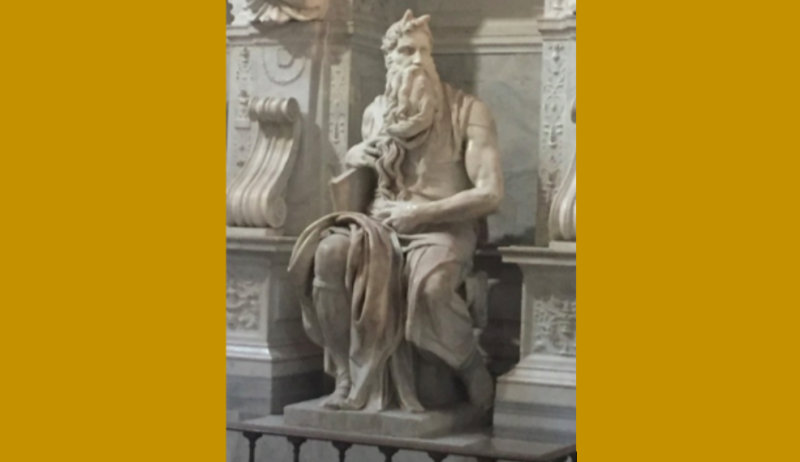In his 1919 paper, The “Uncanny,”1 Freud wrote: “It is only rarely that a psychoanalyst feels impelled to investigate the subject of aesthetics even when aesthetics is understood to mean not merely the theory of beauty, but the theory of the qualities of feeling. He works in other planes of mental life and has little to do with those subdued emotional activities which, inhibited in their aims and dependent upon a multitude of concurrent factors, usually furnish the material for the study of aesthetics”. Five years prior (1914), Freud published “Moses of Michelangelo,”2 in which mattes of aesthetics were thoroughly discussed but nonetheless, were truly only the beginning of a much detailed, systematic and logical investigation.
Freud was at awe with the statue of Moses, it captivated his imagination, he considered it first as “an unsolved riddle to our understanding,”2 and he had put a great deal of effort in trying to give it proper meaning. In Freud’s words: “It is possible, therefore, that a work of art of this kind needs interpretation, and that until I have accomplished that interpretation I cannot come to know why I have been so powerfully affected.”2 Hence, for Freud it was a matter of deciphering, of cracking an enigma, a matter of unravelling “all that is most essential and valuable for the comprehension of this work of art,”2 which lies concealed behind it. An interpretation.
Recently, I too have visited Rome, Freud’s much adored city. Following Freud’s footpaths, I too have “mounted the steep steps from the unlovely Corso Cavour to the lonely piazza”2, where the church of S. Pietro in Vincoli stands, in order to observe Michelangelo’s inscrutable and wonderful work of marble, the statue of Moses. Standing in front of it, I have tried to grasp something of that which had such an impact on Freud, making him return to this place time and again and eventually write his “Moses of Michelangelo”. Reading this paper, it seems that for Freud, examining the statue and interpreting it, was an exemplification for the psychoanalytic technique, as he brought forth a method of a certain art critique who insisted “that attention should be diverted from the general impression and main features of a picture, […] laying stress on the significance of minor details”2. In Freud’s words: “It seems to me that his method of inquiry is closely related to the technique of psycho-analysis. It, too, is accustomed to divine secret and concealed things from despised or unnoticed features, from the rubbish-heap, as it were, of our observations.”2
Yet, more than one-hundred years after the publications of “Moses of Michelangelo” and after I have been acquainted with Lacan’s work and especially his later teaching, it occurred to me that the magnificent statue of Moses may stand as an allegory for the rapport between the Real and the Symbolic. If indeed, as Jacques-Alain Miller asserts, the age of interpretation is behind us,3 what can we make of this glorious piece of Sculpturey? While Freud looked at the statue and meticulously tried to conclude what were the movements which preceded the instant in time at which Moses of Michelangelo is presented to the viewers, what actually ran through my mind was a huge formless meaningless piece of marble that fronted Michelangelo before he began his work. Isn’t this the Real? Homogeneous, amorphous and unbroken, with no gaps in it, without meaning and impossible to interpret. And then, the strikes of the hammer, the artist’s tools as he sculpted and carved his way within this piece of marble, giving it shape and meaning, throwing away the remains, the debris, the objects a which stand for a lack. “The symbolic order captures what is not organized and imposes on it an organization,”4 Miller wrote, “… this organization is a continuity, a meaning, an intention. What appears as a finality is an intention that makes sense.”4 Indeed, a sculpture is not only a beautifully shaped sense-making piece of material we gaze at with wonder. It is also the product of what lacks, what was carved out and tossed away. This is the operation of the Symbolic upon the Real, gaping it, perforating it, breaking and slicing it, so that meaning eventually arises. Like a skillful sculptor working his way through marble, the signifiers work their way through the Real. They enter into the Real, an entry from which a subject is born.5
1 Freud, S., (1919) The ‘Uncanny’, The Standard Edition of the Complete Psychological Works of Sigmund Freud, Volume XVII, pp. 217-256.
2 Freud, S., (1914). The Moses of Michelangelo, The Standard Edition of the Complete Psychological Works of Sigmund Freud. Vol. XIII, pp. 211-237.
3 Miller, J.-A., Interpretation in Reverse, Psychoanalytical Notebooks, Issue 2, 1999.
4 Miller, J.-A., The Lying Truth, The Lacanian Review, Issue 7, Spring 2019, pp. 149-155.
5 Lacan, J., (1962-1963), The Seminar of Jacques Lacan, Book X, Anxiety, tr. A. R. Price, Polity, Cambridge, 2014, p. 87.

